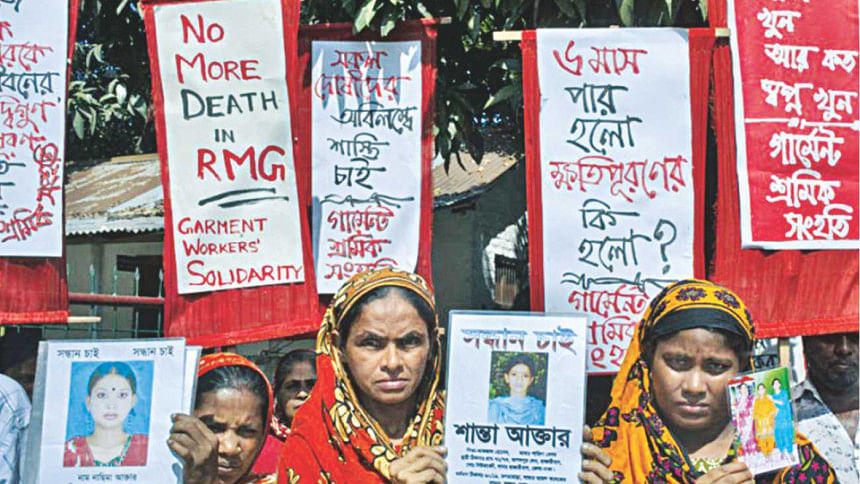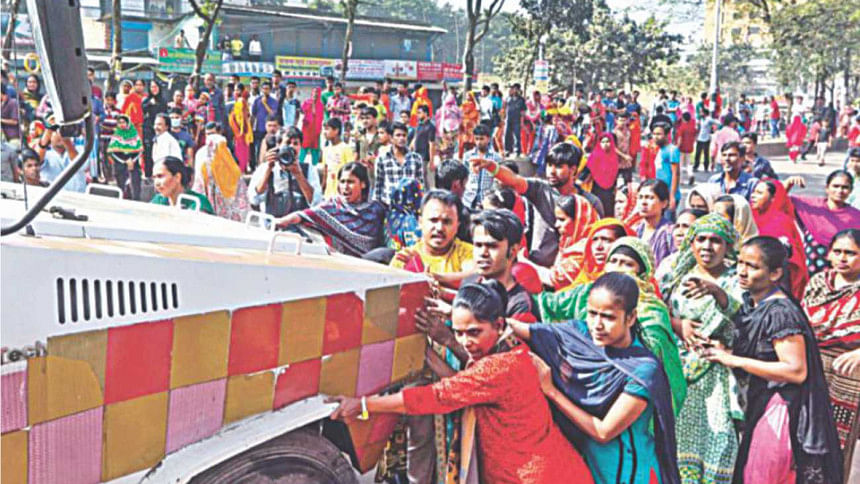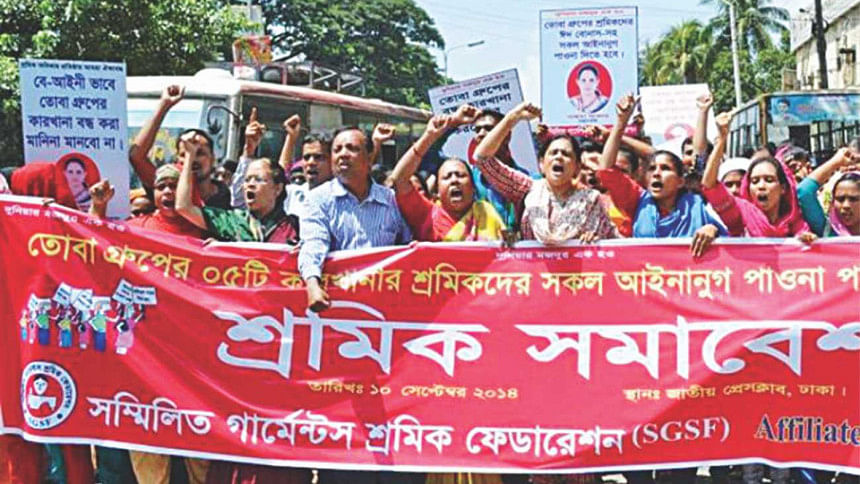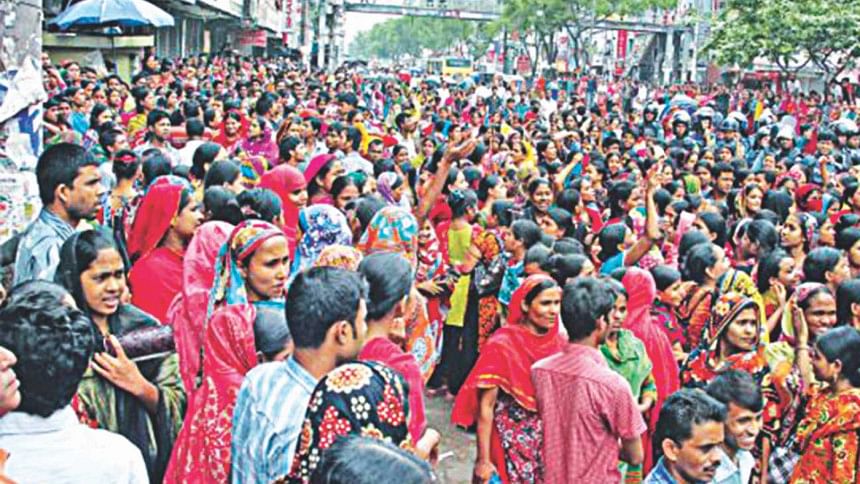Organising Labour under the Neoliberal Gaze

What are the prospects and limits of conventional modes of organising labour in the garment industry, given the current labour rights regime in which the lines between advocacy by non-governmental organisations (NGOs) frequently bleeds into and is occasionally indistinguishable from the activities of some trade unions? In the aftermath of the Rana Plaza collapse in April 2013, "NGOised" trade unions took on increasingly vocal and visible roles. The professionalisation of the trade union model, I suggest, brings with it limitations thrown starkly into relief when we situate the new trade unionism within a longer history of labour activism in Bangladesh. If we look at workers' uprising in recent times, it is clear that fundamental contradictions and constraints remain untouched by the legal and other reforms – much needed as they were – made after 2013.
An implicitly modernist narrative arc that structures mainstream accounts of the post Rana Plaza period — of individual 'tragedy' in the global South that spurs legal reform and improved oversight through the application of external/Northern pressure — obscures critical ground realities. The persuasive power of this narrative depends upon the active forgetting of the past in which workers have secured meaningful change only after embarking on direct action through, often violent, street politics.
Among other things, the discourse around reform effectively sanitises worker resistance by invisibilising the many structural barriers to organising. The evidence so far suggests that without bodily resistance – the literal occupation of public spaces and streets as well as factories – possibilities for meaningful change are minimal given existing political and legal infrastructures. We should also dispense with culturalist explanations of why women in the garment industry are not more active in organising themselves. Dominant constructions of poor Bangladeshi women as passive and/or uneducated and so unable to recognise and act on their own interests, displaces the political for cultural explanations that effectively disguise relations of power.

Neoliberalism itself is a much-contested category. My concern here is not with debates around definition or the specifics of normative prescriptions that go under the sign of neoliberalism. Rather, my analysis is informed by what I call neoliberal sentiment – the discursive parameters and commonsense produced and promoted by neoliberal modes of governance. Here I approach governance as "a discourse to manage and promote the social stability fundamental for capital's accumulation," a process that relies critically "on the networked active participation and self-management of non-state actors such as NGOs and other civil society groups as well as business (Massimo de Angelis 233-234)."
Among other things, neoliberal governance in the transnational realm relies on a language of democracy, equality and rights. By this logic, if the market is ultimately moral, then multinational corporations and their affiliates cannot be seen to be exploitative. In this context, the absolute horror of Rana Plaza as it unfolded in real time constituted a moment of acute crisis by exposing the underbelly of the global supply chain and potentially unleashing "market-unfriendly" sentiments. The sheer scale of the damage ensured that Bangladesh and its garment-producing infrastructure would be subject to global scrutiny. Further, the industrial disaster threatened to undermine the powerful narrative of the market as a site of female empowerment for women in the South.
In the circumstances, it is instructive that the collapse of Rana Plaza, a multipurpose, multi-storied building that housed several garment factories, was widely understood predominantly to be the outcome of (a lack of good) governance, corruption and negligence as well as the greed of an individual factory owner. It goes without saying that implementation and oversight are shockingly poor in Bangladeshi factories, and within the construction industry. Regardless, no one associated with the numerous other commercial ventures housed in Rana Plaza lost their lives. Sensing imminent danger, these establishments shut down operations. Clearly, more than shoddy buildings and inadequate inspections were at stake. This line of inquiry cannot be easily accommodated in a straightforward governance narrative.
Neoliberal sentiment is gendered; echoing its imperial originals, this framing makes women and girls central to the process of development. Correspondingly, female empowerment – of the girl child, of the labouring woman and so on – is invariably an individual endeavor. We see this in the many NGO efforts to empower Bangladeshi garment workers through training on legal literacy, as well as on improving bargaining and leadership skills. While such training is undeniably valuable, the premise underlying the approach (of teaching people to be responsible for their own fates) relies on the assumption that "the problem" is individual rather than systemic. Collective movements that mobilise for structural change in the long run are easily discredited in this environment. The situation calls for an interrogation of the broader political contextthat informs processes of union formation, including the extent of bureaucratic discretion in determining membership and agenda. It is equally critical to situate the new international desire for unions in shifting ideologies of neoliberal governance. It is not incidental that unions have the potential to contain as well as promote labour militancy.

Bangladesh's exclusive 'comparative advantage' is its cheap(ened) and relatively unskilled female labour force. Paradoxically, what is an advantage for the national economy can actually be fatal for the union or individual worker demanding increased wages and improved working conditions. If low labour costs are central to being globally competitive then labour repression can be justified as a valid 'cost' of maintaining the nation's competitive edge. This line of argument becomes even stronger in a place like Bangladesh where the economy is inordinately dependent upon the apparel export industry. Labour resistance can be recast as sedition, as action that directly challenges the nation interest.
A study early on in the industry's growth foregrounds reasons for low levels of unionisation that continue to haveresonance today (S. I. Khan, 2001). Drawing on data collected in 1996, Khan mapped the ways state and capital – in elabourate collusion with each other – systematically deployed bureaucratic power in addition to violent forms of policing to suppress attempts to organise labour. Khan reports that the Directorate of Labour (DoL) routinely refused registration to independent left leaning unions, even if their paperwork was in perfect order, including proof of 30 percent support at the workplace (Khan, 2001: 197). Thus, the culling of radical voices happens at the source. Should such applications slip through, their initiators would confront a host of other obstacles. Close ties between the DoL and factory owners/management enabled the latter to obstruct any effort at union formation. A 'working relation' with the DoL, as well as placing 'spies' in the workforce itself, secures an elabourate and efficient network of surveillance.
In short, the absence of a space for the legitimate voicing of grievances is the other side of numerous spontaneous, demonstrations, blockades, sit-ins, marches and destruction of factory property seen in the garment sector as early as the 1980s. In contrast to this reality, an aura of celebration surrounds news of the increasing number of plant-based unions, the proliferating programmes to train workers on legal literacy and the reform of the labour law ostensibly to ease union formation. In this (neo)liberal telling, modern labour subjectivities (of individuals armed with knowledge of laws and their rights), were waiting to be called into being. Workers are now able to exercise citizenship rights, some newly formed, because they have finally acquired the requisite self-hood.
Recalling a mode of developmentalism rooted in colonial hierarchies, this construction erases the agency of Bangladeshi garment workers and their rich history of resistance. Instead, the focus on individual consciousness renders invisible the structures of power through which some accounts are privileged while others are dismissed.

What are the implications – of control over union actions and agendas – when the process of union formation is top down, not to mention under the gaze of key global players? Under what circumstances would these unions constitute a social force that operates at a level of scale beyond the factory, and would be able to link up with other movements? The answers appear glaringly obvious in some ways.
Under the new amendments, the registrar for trade unions can deny workers the permission to unionise if the official is unsatisfied with the petition. In addition, as in the past, it is evident that left wing unions find it almost impossible to obtain registration. The general impression is that only unions formed with the help of externally funded NGOs (the implication being that they are shorn of any militant agenda, are deemed reasonable/pliant) tend to get approval. According to a sociologist studying post Rana Plaza union conditions, many leaders of newly approved unions are already disillusioned. They come with high expectations but find that they possess little actual power.
The trope of dalal/double agent is a recurring one in labour narratives of unionisation, not surprisingly given the account of surveillance, spying and retaliation noted earlier. Many independent labour leaders see the new unions as company shops, working in the interests of capital. Paradoxically, the amendments have actually made it less cumbersome for owners to dismiss workers accused of 'misconduct'; they can do now without payment. If past practice is any indication, this provision will be used even more to target union activists.
Finally, the government reserved the right to prevent any demonstration or strike it deems 'disruptive' to the community or harmful to the 'national interest.' Suffice it to say, what counts as the national interest or as disruption is open to the logics of power.
The post Rana Plaza period has seen more continuities than ruptures. What then of workers' rights? Perhaps it is time to ask, following Vijay Prashad, if – under prevailing conditions – conventional trade unions are the best form to capture the discontent of workers and to transform their lives? (Prashad 2015:189). It may be time to turn to a broader social movement for change.
Dina M Siddiqi is Professor, BRAC University &Fellow, Center for the Study of Social Difference(CSSD), Columbia University.

 For all latest news, follow The Daily Star's Google News channel.
For all latest news, follow The Daily Star's Google News channel. 



Comments